A Report on Drug Addiction and Social Factors in Australian Seniors
VerifiedAdded on 2023/06/12
|15
|4518
|364
Report
AI Summary
This report examines the issue of drug addiction among senior citizens in Australia, highlighting the prevalence rates, associated risks, and social determinants contributing to this problem. It identifies that a significant proportion of older Australians abuse substances like alcohol, tobacco, and prescription drugs, often exacerbated by chronic health conditions. The report delves into social determinants such as education levels, socioeconomic status, physiological changes, and psychological factors like loneliness and stress. It emphasizes the importance of addressing these social determinants through the combined efforts of various stakeholders to reduce drug abuse among senior citizens and improve their overall health and well-being. Desklib provides access to similar solved assignments and past papers for students.
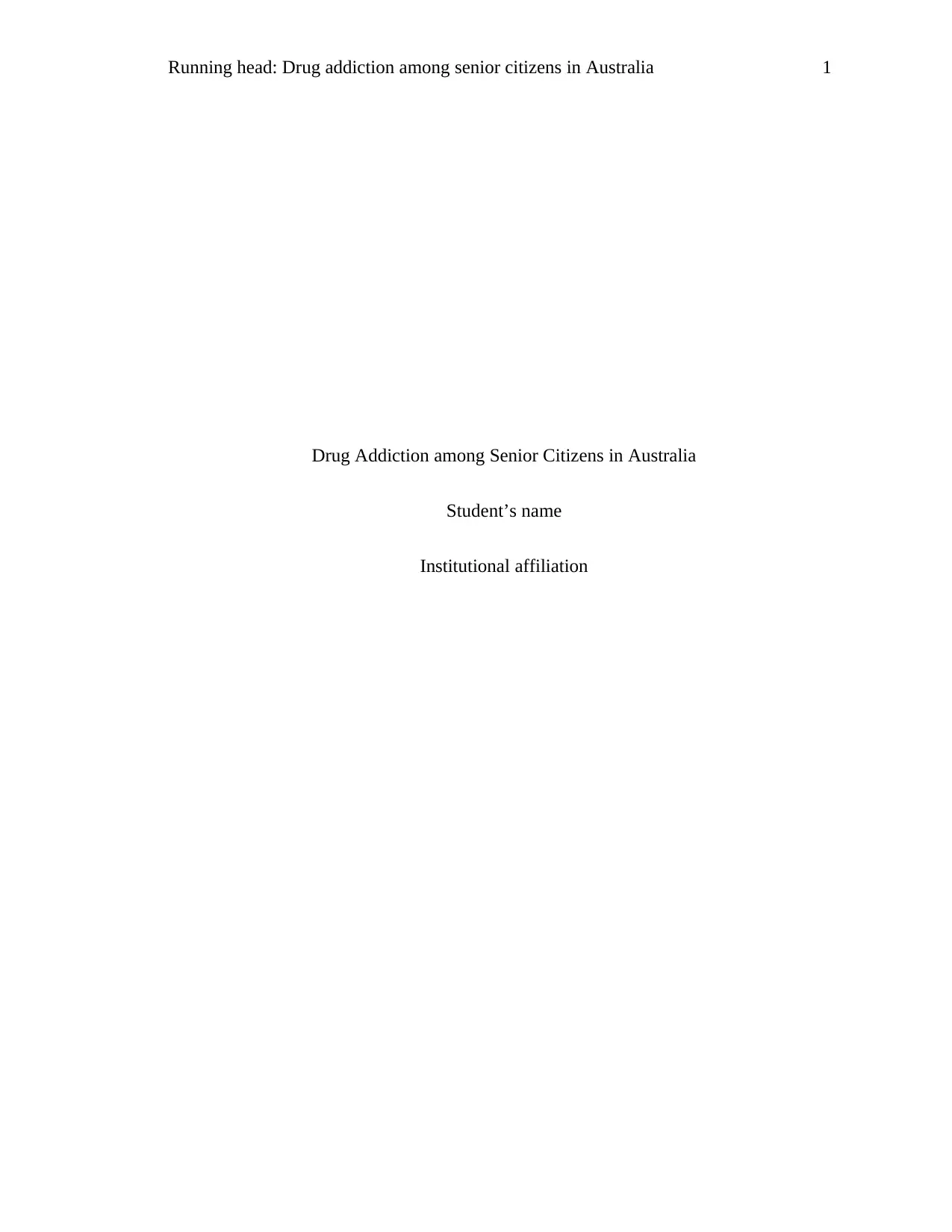
Running head: Drug addiction among senior citizens in Australia 1
Drug Addiction among Senior Citizens in Australia
Student’s name
Institutional affiliation
Drug Addiction among Senior Citizens in Australia
Student’s name
Institutional affiliation
Paraphrase This Document
Need a fresh take? Get an instant paraphrase of this document with our AI Paraphraser
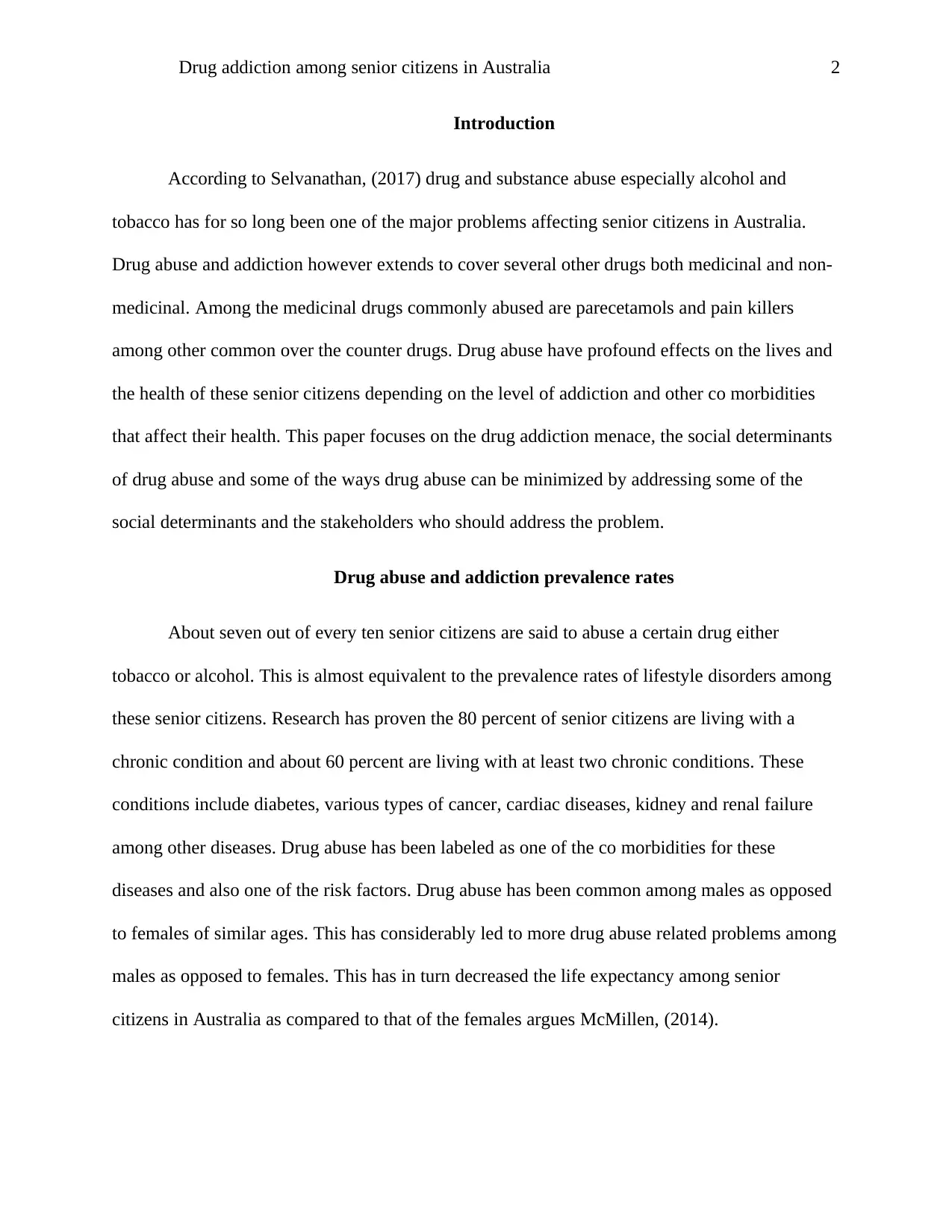
Drug addiction among senior citizens in Australia 2
Introduction
According to Selvanathan, (2017) drug and substance abuse especially alcohol and
tobacco has for so long been one of the major problems affecting senior citizens in Australia.
Drug abuse and addiction however extends to cover several other drugs both medicinal and non-
medicinal. Among the medicinal drugs commonly abused are parecetamols and pain killers
among other common over the counter drugs. Drug abuse have profound effects on the lives and
the health of these senior citizens depending on the level of addiction and other co morbidities
that affect their health. This paper focuses on the drug addiction menace, the social determinants
of drug abuse and some of the ways drug abuse can be minimized by addressing some of the
social determinants and the stakeholders who should address the problem.
Drug abuse and addiction prevalence rates
About seven out of every ten senior citizens are said to abuse a certain drug either
tobacco or alcohol. This is almost equivalent to the prevalence rates of lifestyle disorders among
these senior citizens. Research has proven the 80 percent of senior citizens are living with a
chronic condition and about 60 percent are living with at least two chronic conditions. These
conditions include diabetes, various types of cancer, cardiac diseases, kidney and renal failure
among other diseases. Drug abuse has been labeled as one of the co morbidities for these
diseases and also one of the risk factors. Drug abuse has been common among males as opposed
to females of similar ages. This has considerably led to more drug abuse related problems among
males as opposed to females. This has in turn decreased the life expectancy among senior
citizens in Australia as compared to that of the females argues McMillen, (2014).
Introduction
According to Selvanathan, (2017) drug and substance abuse especially alcohol and
tobacco has for so long been one of the major problems affecting senior citizens in Australia.
Drug abuse and addiction however extends to cover several other drugs both medicinal and non-
medicinal. Among the medicinal drugs commonly abused are parecetamols and pain killers
among other common over the counter drugs. Drug abuse have profound effects on the lives and
the health of these senior citizens depending on the level of addiction and other co morbidities
that affect their health. This paper focuses on the drug addiction menace, the social determinants
of drug abuse and some of the ways drug abuse can be minimized by addressing some of the
social determinants and the stakeholders who should address the problem.
Drug abuse and addiction prevalence rates
About seven out of every ten senior citizens are said to abuse a certain drug either
tobacco or alcohol. This is almost equivalent to the prevalence rates of lifestyle disorders among
these senior citizens. Research has proven the 80 percent of senior citizens are living with a
chronic condition and about 60 percent are living with at least two chronic conditions. These
conditions include diabetes, various types of cancer, cardiac diseases, kidney and renal failure
among other diseases. Drug abuse has been labeled as one of the co morbidities for these
diseases and also one of the risk factors. Drug abuse has been common among males as opposed
to females of similar ages. This has considerably led to more drug abuse related problems among
males as opposed to females. This has in turn decreased the life expectancy among senior
citizens in Australia as compared to that of the females argues McMillen, (2014).
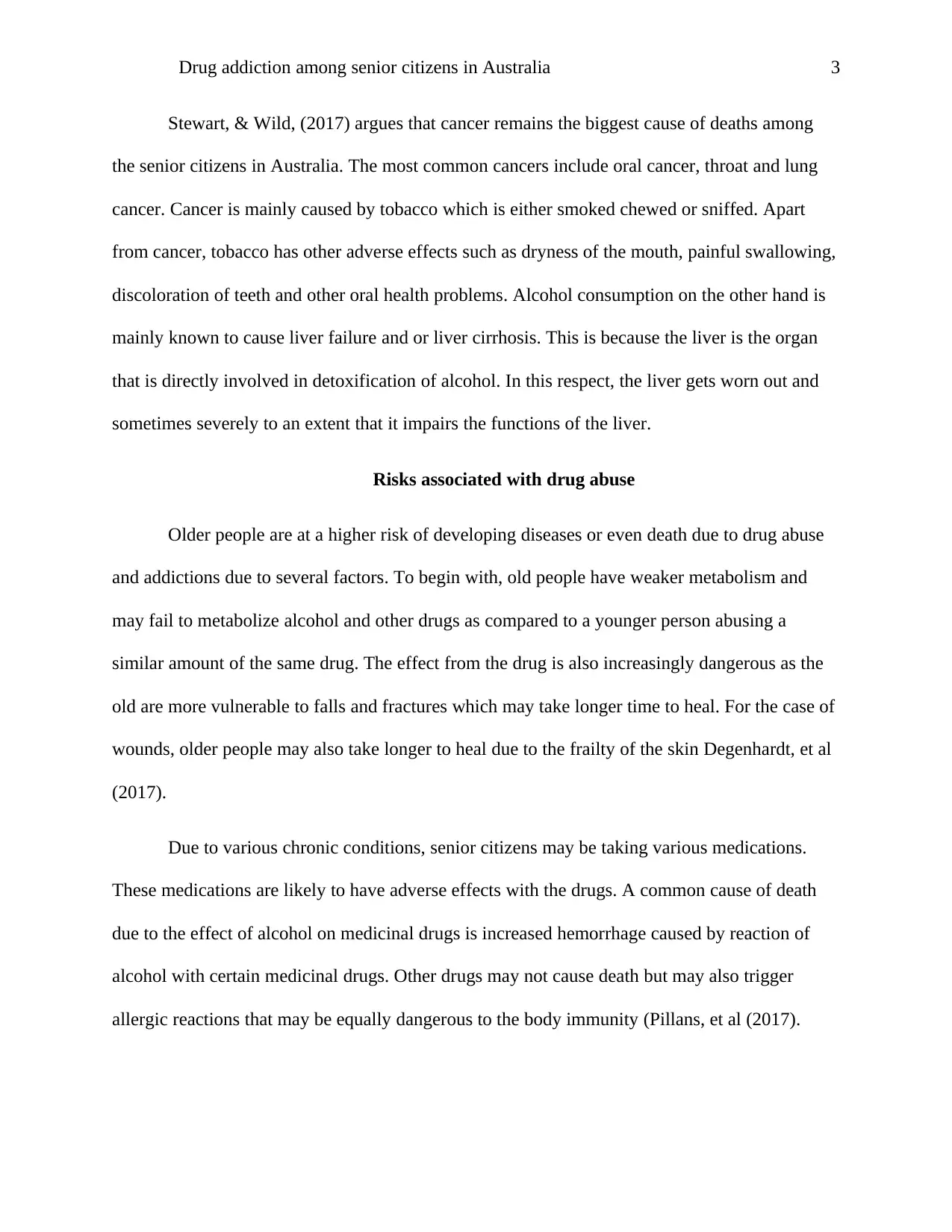
Drug addiction among senior citizens in Australia 3
Stewart, & Wild, (2017) argues that cancer remains the biggest cause of deaths among
the senior citizens in Australia. The most common cancers include oral cancer, throat and lung
cancer. Cancer is mainly caused by tobacco which is either smoked chewed or sniffed. Apart
from cancer, tobacco has other adverse effects such as dryness of the mouth, painful swallowing,
discoloration of teeth and other oral health problems. Alcohol consumption on the other hand is
mainly known to cause liver failure and or liver cirrhosis. This is because the liver is the organ
that is directly involved in detoxification of alcohol. In this respect, the liver gets worn out and
sometimes severely to an extent that it impairs the functions of the liver.
Risks associated with drug abuse
Older people are at a higher risk of developing diseases or even death due to drug abuse
and addictions due to several factors. To begin with, old people have weaker metabolism and
may fail to metabolize alcohol and other drugs as compared to a younger person abusing a
similar amount of the same drug. The effect from the drug is also increasingly dangerous as the
old are more vulnerable to falls and fractures which may take longer time to heal. For the case of
wounds, older people may also take longer to heal due to the frailty of the skin Degenhardt, et al
(2017).
Due to various chronic conditions, senior citizens may be taking various medications.
These medications are likely to have adverse effects with the drugs. A common cause of death
due to the effect of alcohol on medicinal drugs is increased hemorrhage caused by reaction of
alcohol with certain medicinal drugs. Other drugs may not cause death but may also trigger
allergic reactions that may be equally dangerous to the body immunity (Pillans, et al (2017).
Stewart, & Wild, (2017) argues that cancer remains the biggest cause of deaths among
the senior citizens in Australia. The most common cancers include oral cancer, throat and lung
cancer. Cancer is mainly caused by tobacco which is either smoked chewed or sniffed. Apart
from cancer, tobacco has other adverse effects such as dryness of the mouth, painful swallowing,
discoloration of teeth and other oral health problems. Alcohol consumption on the other hand is
mainly known to cause liver failure and or liver cirrhosis. This is because the liver is the organ
that is directly involved in detoxification of alcohol. In this respect, the liver gets worn out and
sometimes severely to an extent that it impairs the functions of the liver.
Risks associated with drug abuse
Older people are at a higher risk of developing diseases or even death due to drug abuse
and addictions due to several factors. To begin with, old people have weaker metabolism and
may fail to metabolize alcohol and other drugs as compared to a younger person abusing a
similar amount of the same drug. The effect from the drug is also increasingly dangerous as the
old are more vulnerable to falls and fractures which may take longer time to heal. For the case of
wounds, older people may also take longer to heal due to the frailty of the skin Degenhardt, et al
(2017).
Due to various chronic conditions, senior citizens may be taking various medications.
These medications are likely to have adverse effects with the drugs. A common cause of death
due to the effect of alcohol on medicinal drugs is increased hemorrhage caused by reaction of
alcohol with certain medicinal drugs. Other drugs may not cause death but may also trigger
allergic reactions that may be equally dangerous to the body immunity (Pillans, et al (2017).
⊘ This is a preview!⊘
Do you want full access?
Subscribe today to unlock all pages.

Trusted by 1+ million students worldwide
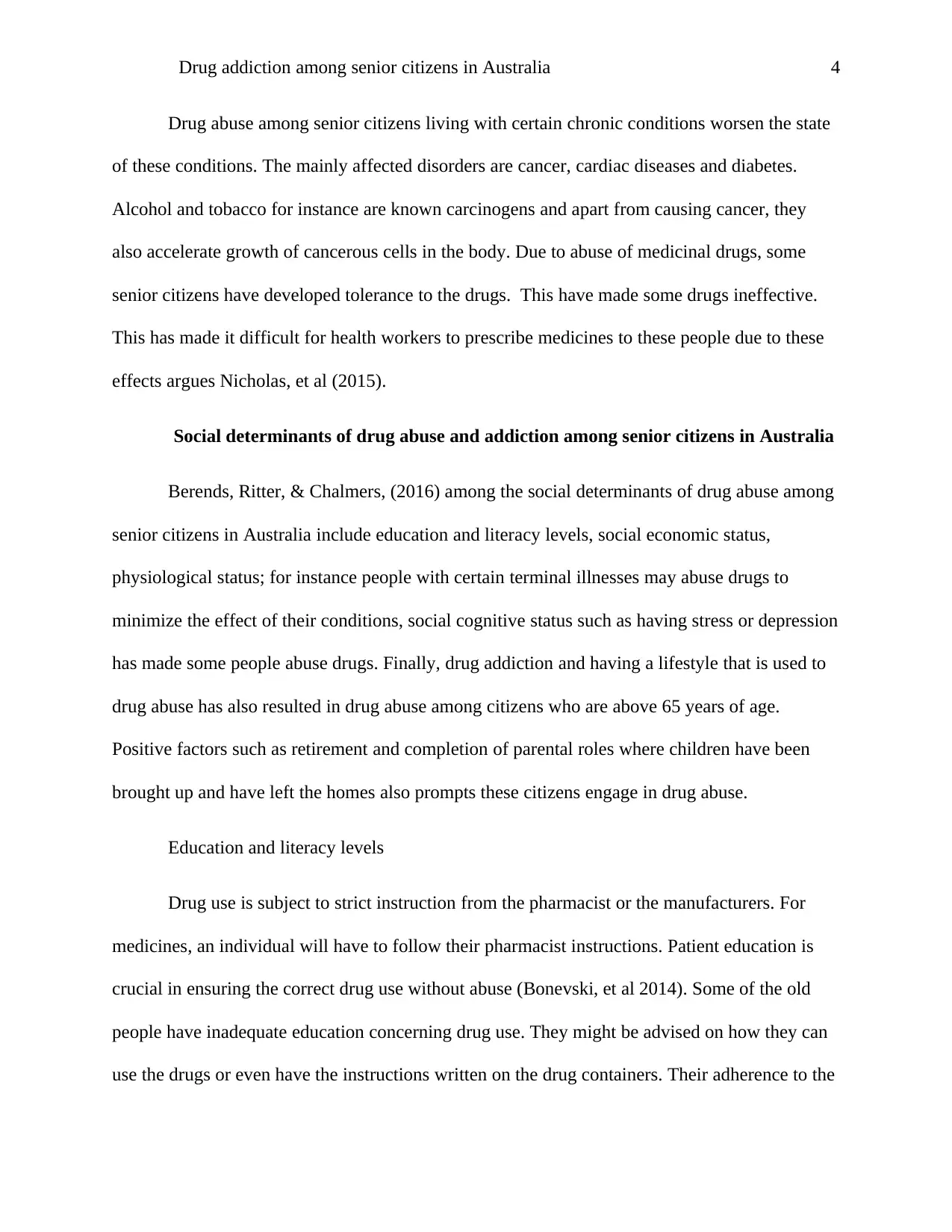
Drug addiction among senior citizens in Australia 4
Drug abuse among senior citizens living with certain chronic conditions worsen the state
of these conditions. The mainly affected disorders are cancer, cardiac diseases and diabetes.
Alcohol and tobacco for instance are known carcinogens and apart from causing cancer, they
also accelerate growth of cancerous cells in the body. Due to abuse of medicinal drugs, some
senior citizens have developed tolerance to the drugs. This have made some drugs ineffective.
This has made it difficult for health workers to prescribe medicines to these people due to these
effects argues Nicholas, et al (2015).
Social determinants of drug abuse and addiction among senior citizens in Australia
Berends, Ritter, & Chalmers, (2016) among the social determinants of drug abuse among
senior citizens in Australia include education and literacy levels, social economic status,
physiological status; for instance people with certain terminal illnesses may abuse drugs to
minimize the effect of their conditions, social cognitive status such as having stress or depression
has made some people abuse drugs. Finally, drug addiction and having a lifestyle that is used to
drug abuse has also resulted in drug abuse among citizens who are above 65 years of age.
Positive factors such as retirement and completion of parental roles where children have been
brought up and have left the homes also prompts these citizens engage in drug abuse.
Education and literacy levels
Drug use is subject to strict instruction from the pharmacist or the manufacturers. For
medicines, an individual will have to follow their pharmacist instructions. Patient education is
crucial in ensuring the correct drug use without abuse (Bonevski, et al 2014). Some of the old
people have inadequate education concerning drug use. They might be advised on how they can
use the drugs or even have the instructions written on the drug containers. Their adherence to the
Drug abuse among senior citizens living with certain chronic conditions worsen the state
of these conditions. The mainly affected disorders are cancer, cardiac diseases and diabetes.
Alcohol and tobacco for instance are known carcinogens and apart from causing cancer, they
also accelerate growth of cancerous cells in the body. Due to abuse of medicinal drugs, some
senior citizens have developed tolerance to the drugs. This have made some drugs ineffective.
This has made it difficult for health workers to prescribe medicines to these people due to these
effects argues Nicholas, et al (2015).
Social determinants of drug abuse and addiction among senior citizens in Australia
Berends, Ritter, & Chalmers, (2016) among the social determinants of drug abuse among
senior citizens in Australia include education and literacy levels, social economic status,
physiological status; for instance people with certain terminal illnesses may abuse drugs to
minimize the effect of their conditions, social cognitive status such as having stress or depression
has made some people abuse drugs. Finally, drug addiction and having a lifestyle that is used to
drug abuse has also resulted in drug abuse among citizens who are above 65 years of age.
Positive factors such as retirement and completion of parental roles where children have been
brought up and have left the homes also prompts these citizens engage in drug abuse.
Education and literacy levels
Drug use is subject to strict instruction from the pharmacist or the manufacturers. For
medicines, an individual will have to follow their pharmacist instructions. Patient education is
crucial in ensuring the correct drug use without abuse (Bonevski, et al 2014). Some of the old
people have inadequate education concerning drug use. They might be advised on how they can
use the drugs or even have the instructions written on the drug containers. Their adherence to the
Paraphrase This Document
Need a fresh take? Get an instant paraphrase of this document with our AI Paraphraser
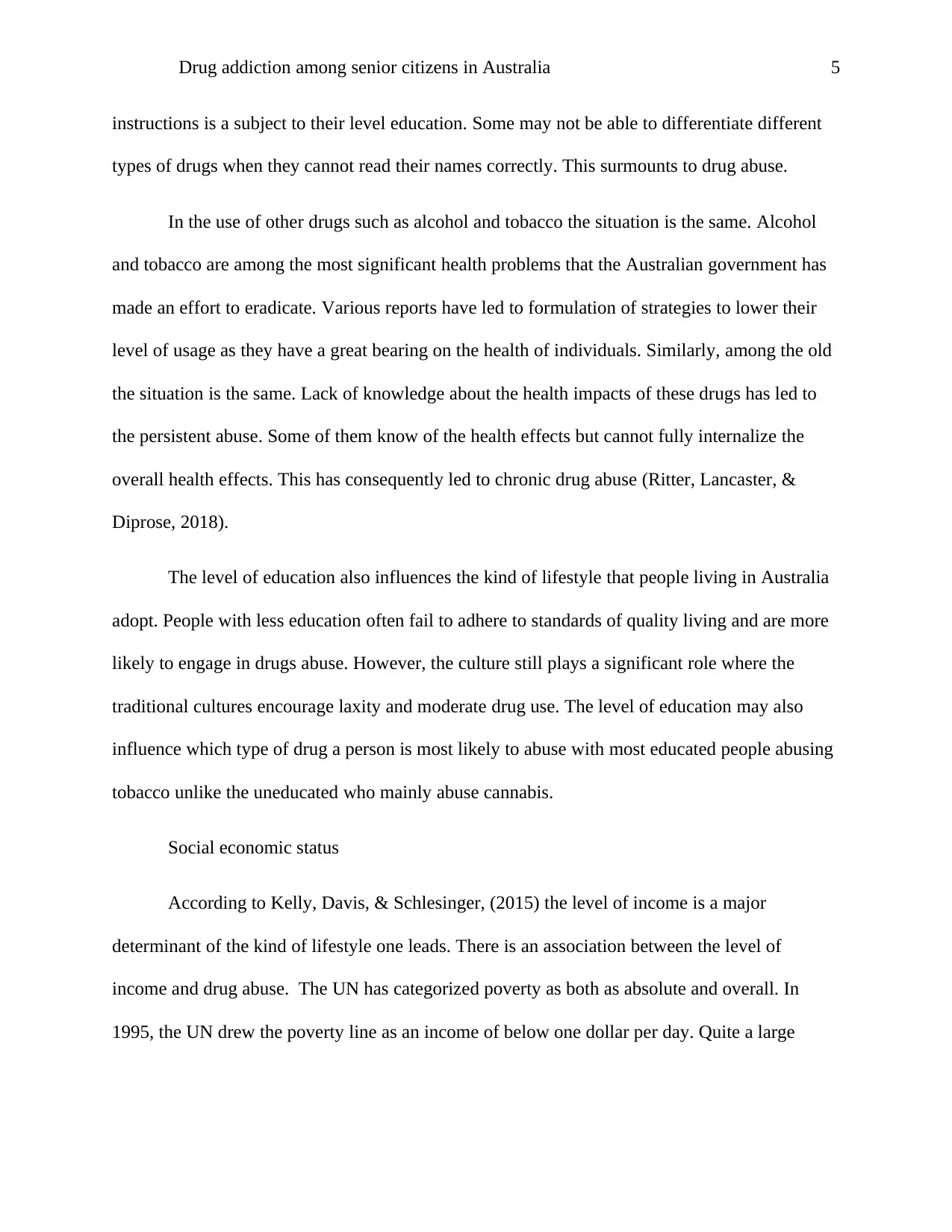
Drug addiction among senior citizens in Australia 5
instructions is a subject to their level education. Some may not be able to differentiate different
types of drugs when they cannot read their names correctly. This surmounts to drug abuse.
In the use of other drugs such as alcohol and tobacco the situation is the same. Alcohol
and tobacco are among the most significant health problems that the Australian government has
made an effort to eradicate. Various reports have led to formulation of strategies to lower their
level of usage as they have a great bearing on the health of individuals. Similarly, among the old
the situation is the same. Lack of knowledge about the health impacts of these drugs has led to
the persistent abuse. Some of them know of the health effects but cannot fully internalize the
overall health effects. This has consequently led to chronic drug abuse (Ritter, Lancaster, &
Diprose, 2018).
The level of education also influences the kind of lifestyle that people living in Australia
adopt. People with less education often fail to adhere to standards of quality living and are more
likely to engage in drugs abuse. However, the culture still plays a significant role where the
traditional cultures encourage laxity and moderate drug use. The level of education may also
influence which type of drug a person is most likely to abuse with most educated people abusing
tobacco unlike the uneducated who mainly abuse cannabis.
Social economic status
According to Kelly, Davis, & Schlesinger, (2015) the level of income is a major
determinant of the kind of lifestyle one leads. There is an association between the level of
income and drug abuse. The UN has categorized poverty as both as absolute and overall. In
1995, the UN drew the poverty line as an income of below one dollar per day. Quite a large
instructions is a subject to their level education. Some may not be able to differentiate different
types of drugs when they cannot read their names correctly. This surmounts to drug abuse.
In the use of other drugs such as alcohol and tobacco the situation is the same. Alcohol
and tobacco are among the most significant health problems that the Australian government has
made an effort to eradicate. Various reports have led to formulation of strategies to lower their
level of usage as they have a great bearing on the health of individuals. Similarly, among the old
the situation is the same. Lack of knowledge about the health impacts of these drugs has led to
the persistent abuse. Some of them know of the health effects but cannot fully internalize the
overall health effects. This has consequently led to chronic drug abuse (Ritter, Lancaster, &
Diprose, 2018).
The level of education also influences the kind of lifestyle that people living in Australia
adopt. People with less education often fail to adhere to standards of quality living and are more
likely to engage in drugs abuse. However, the culture still plays a significant role where the
traditional cultures encourage laxity and moderate drug use. The level of education may also
influence which type of drug a person is most likely to abuse with most educated people abusing
tobacco unlike the uneducated who mainly abuse cannabis.
Social economic status
According to Kelly, Davis, & Schlesinger, (2015) the level of income is a major
determinant of the kind of lifestyle one leads. There is an association between the level of
income and drug abuse. The UN has categorized poverty as both as absolute and overall. In
1995, the UN drew the poverty line as an income of below one dollar per day. Quite a large
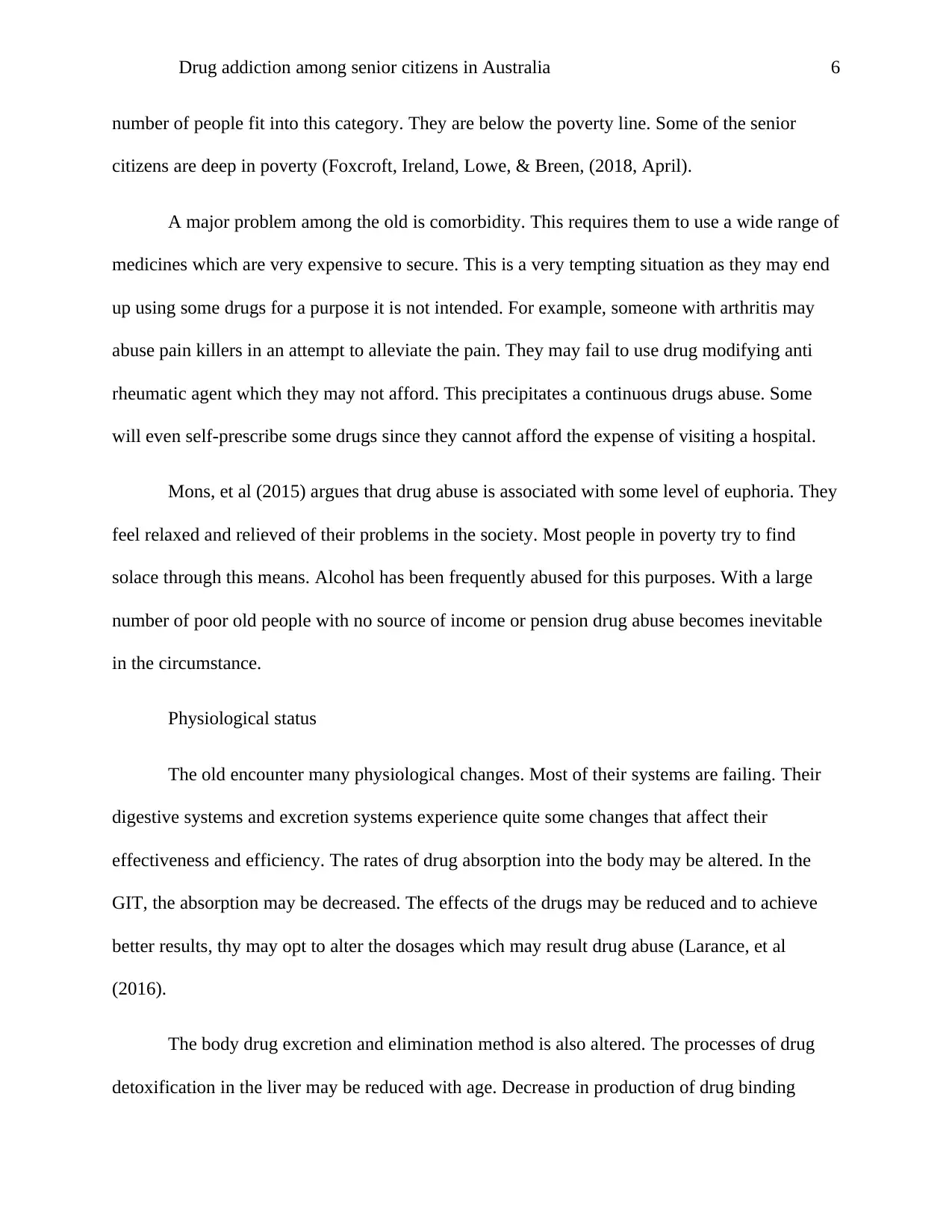
Drug addiction among senior citizens in Australia 6
number of people fit into this category. They are below the poverty line. Some of the senior
citizens are deep in poverty (Foxcroft, Ireland, Lowe, & Breen, (2018, April).
A major problem among the old is comorbidity. This requires them to use a wide range of
medicines which are very expensive to secure. This is a very tempting situation as they may end
up using some drugs for a purpose it is not intended. For example, someone with arthritis may
abuse pain killers in an attempt to alleviate the pain. They may fail to use drug modifying anti
rheumatic agent which they may not afford. This precipitates a continuous drugs abuse. Some
will even self-prescribe some drugs since they cannot afford the expense of visiting a hospital.
Mons, et al (2015) argues that drug abuse is associated with some level of euphoria. They
feel relaxed and relieved of their problems in the society. Most people in poverty try to find
solace through this means. Alcohol has been frequently abused for this purposes. With a large
number of poor old people with no source of income or pension drug abuse becomes inevitable
in the circumstance.
Physiological status
The old encounter many physiological changes. Most of their systems are failing. Their
digestive systems and excretion systems experience quite some changes that affect their
effectiveness and efficiency. The rates of drug absorption into the body may be altered. In the
GIT, the absorption may be decreased. The effects of the drugs may be reduced and to achieve
better results, thy may opt to alter the dosages which may result drug abuse (Larance, et al
(2016).
The body drug excretion and elimination method is also altered. The processes of drug
detoxification in the liver may be reduced with age. Decrease in production of drug binding
number of people fit into this category. They are below the poverty line. Some of the senior
citizens are deep in poverty (Foxcroft, Ireland, Lowe, & Breen, (2018, April).
A major problem among the old is comorbidity. This requires them to use a wide range of
medicines which are very expensive to secure. This is a very tempting situation as they may end
up using some drugs for a purpose it is not intended. For example, someone with arthritis may
abuse pain killers in an attempt to alleviate the pain. They may fail to use drug modifying anti
rheumatic agent which they may not afford. This precipitates a continuous drugs abuse. Some
will even self-prescribe some drugs since they cannot afford the expense of visiting a hospital.
Mons, et al (2015) argues that drug abuse is associated with some level of euphoria. They
feel relaxed and relieved of their problems in the society. Most people in poverty try to find
solace through this means. Alcohol has been frequently abused for this purposes. With a large
number of poor old people with no source of income or pension drug abuse becomes inevitable
in the circumstance.
Physiological status
The old encounter many physiological changes. Most of their systems are failing. Their
digestive systems and excretion systems experience quite some changes that affect their
effectiveness and efficiency. The rates of drug absorption into the body may be altered. In the
GIT, the absorption may be decreased. The effects of the drugs may be reduced and to achieve
better results, thy may opt to alter the dosages which may result drug abuse (Larance, et al
(2016).
The body drug excretion and elimination method is also altered. The processes of drug
detoxification in the liver may be reduced with age. Decrease in production of drug binding
⊘ This is a preview!⊘
Do you want full access?
Subscribe today to unlock all pages.

Trusted by 1+ million students worldwide
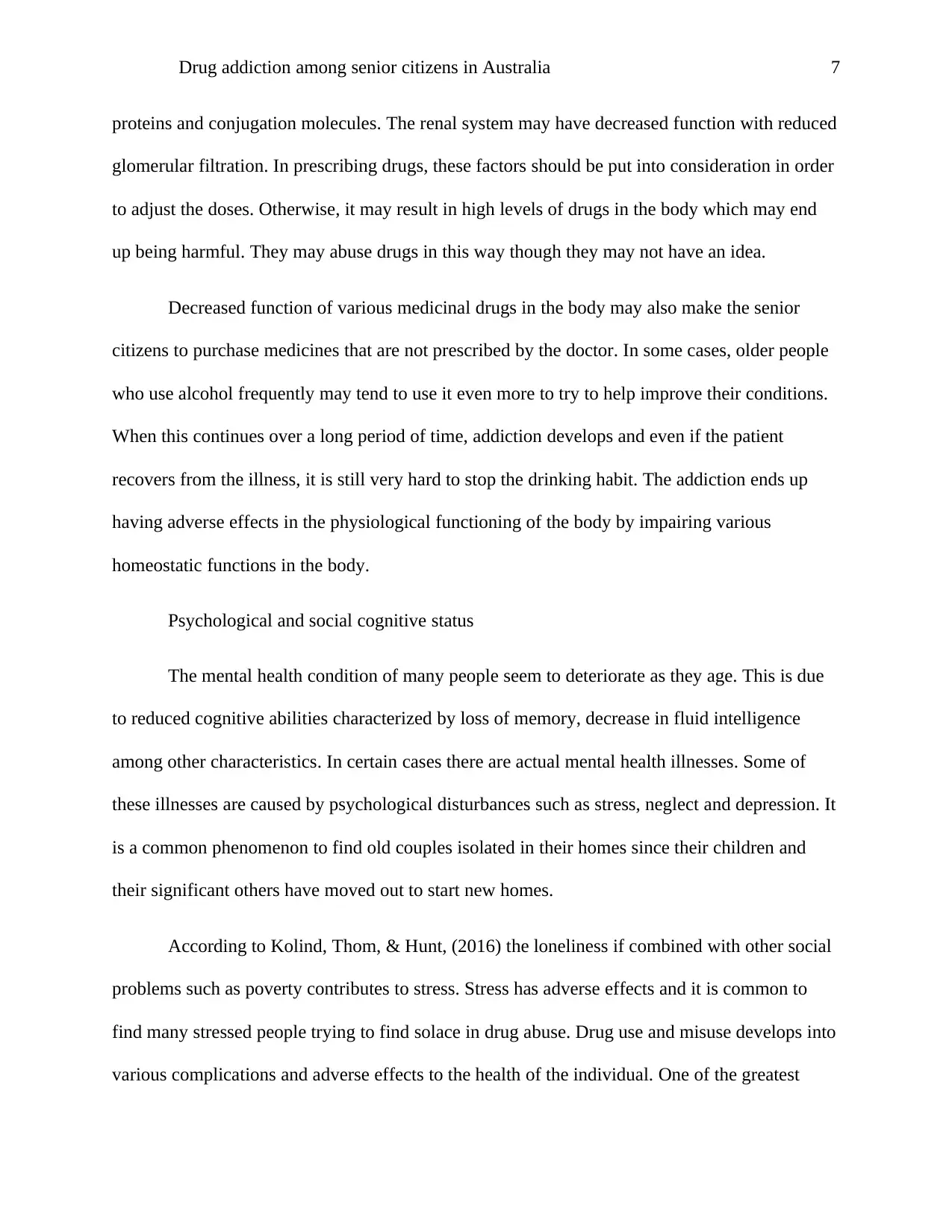
Drug addiction among senior citizens in Australia 7
proteins and conjugation molecules. The renal system may have decreased function with reduced
glomerular filtration. In prescribing drugs, these factors should be put into consideration in order
to adjust the doses. Otherwise, it may result in high levels of drugs in the body which may end
up being harmful. They may abuse drugs in this way though they may not have an idea.
Decreased function of various medicinal drugs in the body may also make the senior
citizens to purchase medicines that are not prescribed by the doctor. In some cases, older people
who use alcohol frequently may tend to use it even more to try to help improve their conditions.
When this continues over a long period of time, addiction develops and even if the patient
recovers from the illness, it is still very hard to stop the drinking habit. The addiction ends up
having adverse effects in the physiological functioning of the body by impairing various
homeostatic functions in the body.
Psychological and social cognitive status
The mental health condition of many people seem to deteriorate as they age. This is due
to reduced cognitive abilities characterized by loss of memory, decrease in fluid intelligence
among other characteristics. In certain cases there are actual mental health illnesses. Some of
these illnesses are caused by psychological disturbances such as stress, neglect and depression. It
is a common phenomenon to find old couples isolated in their homes since their children and
their significant others have moved out to start new homes.
According to Kolind, Thom, & Hunt, (2016) the loneliness if combined with other social
problems such as poverty contributes to stress. Stress has adverse effects and it is common to
find many stressed people trying to find solace in drug abuse. Drug use and misuse develops into
various complications and adverse effects to the health of the individual. One of the greatest
proteins and conjugation molecules. The renal system may have decreased function with reduced
glomerular filtration. In prescribing drugs, these factors should be put into consideration in order
to adjust the doses. Otherwise, it may result in high levels of drugs in the body which may end
up being harmful. They may abuse drugs in this way though they may not have an idea.
Decreased function of various medicinal drugs in the body may also make the senior
citizens to purchase medicines that are not prescribed by the doctor. In some cases, older people
who use alcohol frequently may tend to use it even more to try to help improve their conditions.
When this continues over a long period of time, addiction develops and even if the patient
recovers from the illness, it is still very hard to stop the drinking habit. The addiction ends up
having adverse effects in the physiological functioning of the body by impairing various
homeostatic functions in the body.
Psychological and social cognitive status
The mental health condition of many people seem to deteriorate as they age. This is due
to reduced cognitive abilities characterized by loss of memory, decrease in fluid intelligence
among other characteristics. In certain cases there are actual mental health illnesses. Some of
these illnesses are caused by psychological disturbances such as stress, neglect and depression. It
is a common phenomenon to find old couples isolated in their homes since their children and
their significant others have moved out to start new homes.
According to Kolind, Thom, & Hunt, (2016) the loneliness if combined with other social
problems such as poverty contributes to stress. Stress has adverse effects and it is common to
find many stressed people trying to find solace in drug abuse. Drug use and misuse develops into
various complications and adverse effects to the health of the individual. One of the greatest
Paraphrase This Document
Need a fresh take? Get an instant paraphrase of this document with our AI Paraphraser
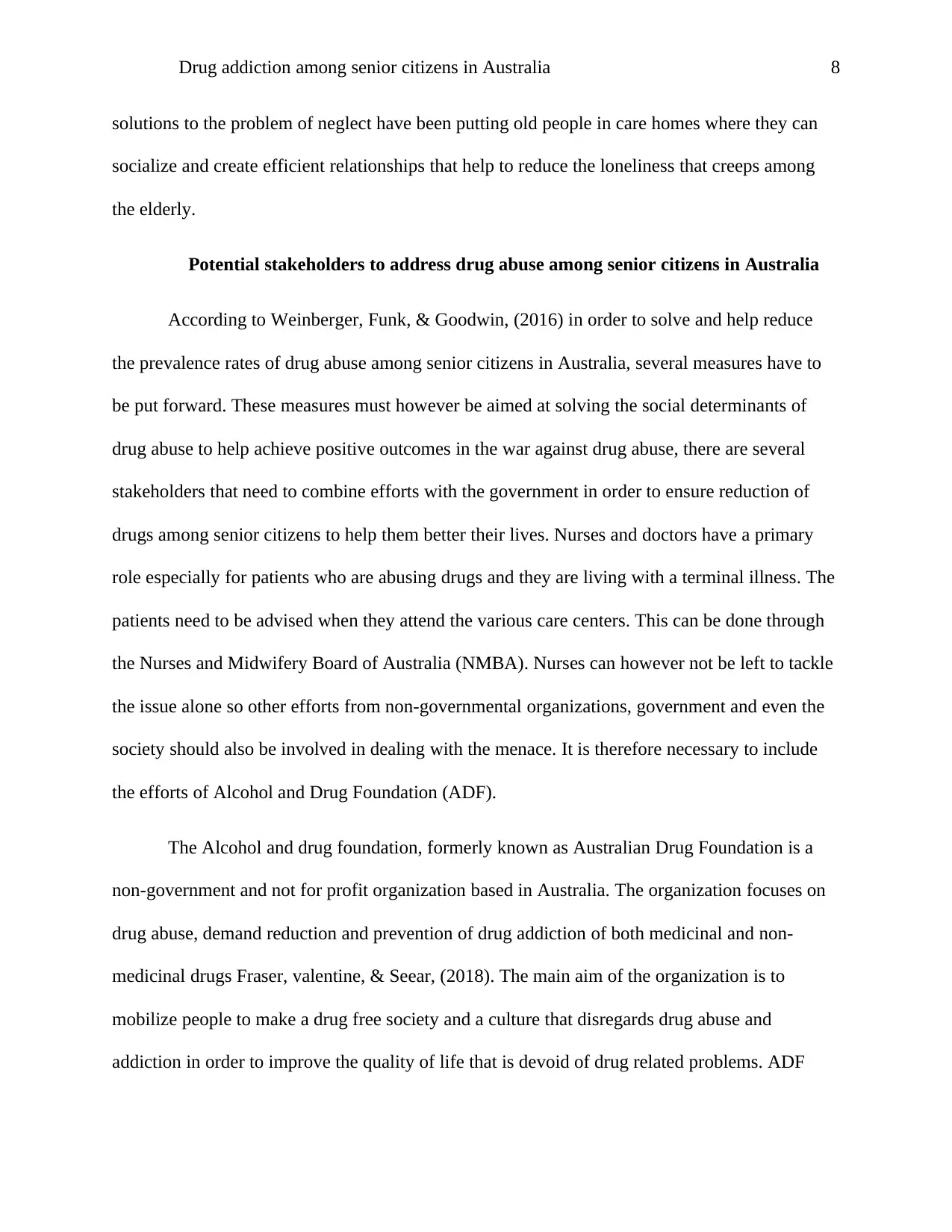
Drug addiction among senior citizens in Australia 8
solutions to the problem of neglect have been putting old people in care homes where they can
socialize and create efficient relationships that help to reduce the loneliness that creeps among
the elderly.
Potential stakeholders to address drug abuse among senior citizens in Australia
According to Weinberger, Funk, & Goodwin, (2016) in order to solve and help reduce
the prevalence rates of drug abuse among senior citizens in Australia, several measures have to
be put forward. These measures must however be aimed at solving the social determinants of
drug abuse to help achieve positive outcomes in the war against drug abuse, there are several
stakeholders that need to combine efforts with the government in order to ensure reduction of
drugs among senior citizens to help them better their lives. Nurses and doctors have a primary
role especially for patients who are abusing drugs and they are living with a terminal illness. The
patients need to be advised when they attend the various care centers. This can be done through
the Nurses and Midwifery Board of Australia (NMBA). Nurses can however not be left to tackle
the issue alone so other efforts from non-governmental organizations, government and even the
society should also be involved in dealing with the menace. It is therefore necessary to include
the efforts of Alcohol and Drug Foundation (ADF).
The Alcohol and drug foundation, formerly known as Australian Drug Foundation is a
non-government and not for profit organization based in Australia. The organization focuses on
drug abuse, demand reduction and prevention of drug addiction of both medicinal and non-
medicinal drugs Fraser, valentine, & Seear, (2018). The main aim of the organization is to
mobilize people to make a drug free society and a culture that disregards drug abuse and
addiction in order to improve the quality of life that is devoid of drug related problems. ADF
solutions to the problem of neglect have been putting old people in care homes where they can
socialize and create efficient relationships that help to reduce the loneliness that creeps among
the elderly.
Potential stakeholders to address drug abuse among senior citizens in Australia
According to Weinberger, Funk, & Goodwin, (2016) in order to solve and help reduce
the prevalence rates of drug abuse among senior citizens in Australia, several measures have to
be put forward. These measures must however be aimed at solving the social determinants of
drug abuse to help achieve positive outcomes in the war against drug abuse, there are several
stakeholders that need to combine efforts with the government in order to ensure reduction of
drugs among senior citizens to help them better their lives. Nurses and doctors have a primary
role especially for patients who are abusing drugs and they are living with a terminal illness. The
patients need to be advised when they attend the various care centers. This can be done through
the Nurses and Midwifery Board of Australia (NMBA). Nurses can however not be left to tackle
the issue alone so other efforts from non-governmental organizations, government and even the
society should also be involved in dealing with the menace. It is therefore necessary to include
the efforts of Alcohol and Drug Foundation (ADF).
The Alcohol and drug foundation, formerly known as Australian Drug Foundation is a
non-government and not for profit organization based in Australia. The organization focuses on
drug abuse, demand reduction and prevention of drug addiction of both medicinal and non-
medicinal drugs Fraser, valentine, & Seear, (2018). The main aim of the organization is to
mobilize people to make a drug free society and a culture that disregards drug abuse and
addiction in order to improve the quality of life that is devoid of drug related problems. ADF
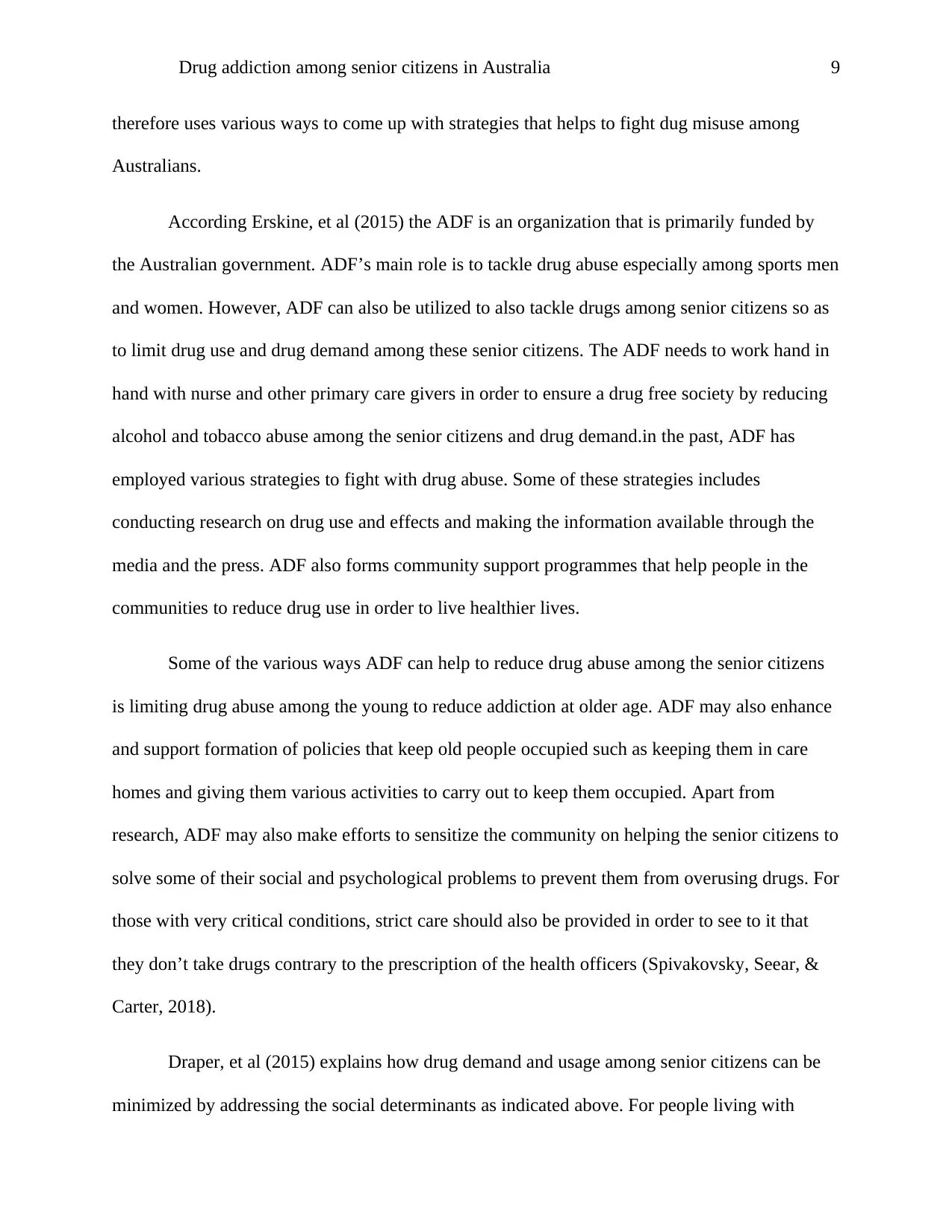
Drug addiction among senior citizens in Australia 9
therefore uses various ways to come up with strategies that helps to fight dug misuse among
Australians.
According Erskine, et al (2015) the ADF is an organization that is primarily funded by
the Australian government. ADF’s main role is to tackle drug abuse especially among sports men
and women. However, ADF can also be utilized to also tackle drugs among senior citizens so as
to limit drug use and drug demand among these senior citizens. The ADF needs to work hand in
hand with nurse and other primary care givers in order to ensure a drug free society by reducing
alcohol and tobacco abuse among the senior citizens and drug demand.in the past, ADF has
employed various strategies to fight with drug abuse. Some of these strategies includes
conducting research on drug use and effects and making the information available through the
media and the press. ADF also forms community support programmes that help people in the
communities to reduce drug use in order to live healthier lives.
Some of the various ways ADF can help to reduce drug abuse among the senior citizens
is limiting drug abuse among the young to reduce addiction at older age. ADF may also enhance
and support formation of policies that keep old people occupied such as keeping them in care
homes and giving them various activities to carry out to keep them occupied. Apart from
research, ADF may also make efforts to sensitize the community on helping the senior citizens to
solve some of their social and psychological problems to prevent them from overusing drugs. For
those with very critical conditions, strict care should also be provided in order to see to it that
they don’t take drugs contrary to the prescription of the health officers (Spivakovsky, Seear, &
Carter, 2018).
Draper, et al (2015) explains how drug demand and usage among senior citizens can be
minimized by addressing the social determinants as indicated above. For people living with
therefore uses various ways to come up with strategies that helps to fight dug misuse among
Australians.
According Erskine, et al (2015) the ADF is an organization that is primarily funded by
the Australian government. ADF’s main role is to tackle drug abuse especially among sports men
and women. However, ADF can also be utilized to also tackle drugs among senior citizens so as
to limit drug use and drug demand among these senior citizens. The ADF needs to work hand in
hand with nurse and other primary care givers in order to ensure a drug free society by reducing
alcohol and tobacco abuse among the senior citizens and drug demand.in the past, ADF has
employed various strategies to fight with drug abuse. Some of these strategies includes
conducting research on drug use and effects and making the information available through the
media and the press. ADF also forms community support programmes that help people in the
communities to reduce drug use in order to live healthier lives.
Some of the various ways ADF can help to reduce drug abuse among the senior citizens
is limiting drug abuse among the young to reduce addiction at older age. ADF may also enhance
and support formation of policies that keep old people occupied such as keeping them in care
homes and giving them various activities to carry out to keep them occupied. Apart from
research, ADF may also make efforts to sensitize the community on helping the senior citizens to
solve some of their social and psychological problems to prevent them from overusing drugs. For
those with very critical conditions, strict care should also be provided in order to see to it that
they don’t take drugs contrary to the prescription of the health officers (Spivakovsky, Seear, &
Carter, 2018).
Draper, et al (2015) explains how drug demand and usage among senior citizens can be
minimized by addressing the social determinants as indicated above. For people living with
⊘ This is a preview!⊘
Do you want full access?
Subscribe today to unlock all pages.

Trusted by 1+ million students worldwide
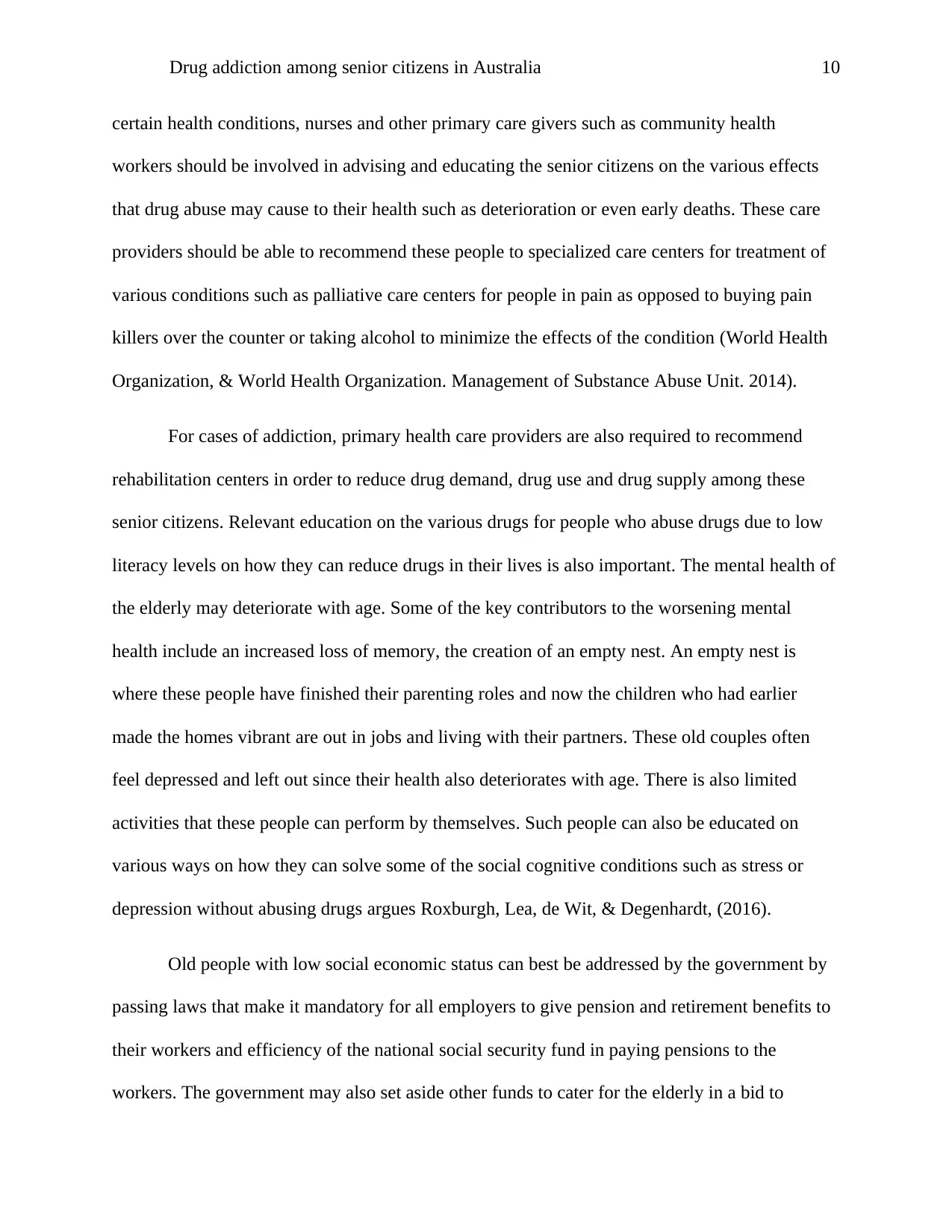
Drug addiction among senior citizens in Australia 10
certain health conditions, nurses and other primary care givers such as community health
workers should be involved in advising and educating the senior citizens on the various effects
that drug abuse may cause to their health such as deterioration or even early deaths. These care
providers should be able to recommend these people to specialized care centers for treatment of
various conditions such as palliative care centers for people in pain as opposed to buying pain
killers over the counter or taking alcohol to minimize the effects of the condition (World Health
Organization, & World Health Organization. Management of Substance Abuse Unit. 2014).
For cases of addiction, primary health care providers are also required to recommend
rehabilitation centers in order to reduce drug demand, drug use and drug supply among these
senior citizens. Relevant education on the various drugs for people who abuse drugs due to low
literacy levels on how they can reduce drugs in their lives is also important. The mental health of
the elderly may deteriorate with age. Some of the key contributors to the worsening mental
health include an increased loss of memory, the creation of an empty nest. An empty nest is
where these people have finished their parenting roles and now the children who had earlier
made the homes vibrant are out in jobs and living with their partners. These old couples often
feel depressed and left out since their health also deteriorates with age. There is also limited
activities that these people can perform by themselves. Such people can also be educated on
various ways on how they can solve some of the social cognitive conditions such as stress or
depression without abusing drugs argues Roxburgh, Lea, de Wit, & Degenhardt, (2016).
Old people with low social economic status can best be addressed by the government by
passing laws that make it mandatory for all employers to give pension and retirement benefits to
their workers and efficiency of the national social security fund in paying pensions to the
workers. The government may also set aside other funds to cater for the elderly in a bid to
certain health conditions, nurses and other primary care givers such as community health
workers should be involved in advising and educating the senior citizens on the various effects
that drug abuse may cause to their health such as deterioration or even early deaths. These care
providers should be able to recommend these people to specialized care centers for treatment of
various conditions such as palliative care centers for people in pain as opposed to buying pain
killers over the counter or taking alcohol to minimize the effects of the condition (World Health
Organization, & World Health Organization. Management of Substance Abuse Unit. 2014).
For cases of addiction, primary health care providers are also required to recommend
rehabilitation centers in order to reduce drug demand, drug use and drug supply among these
senior citizens. Relevant education on the various drugs for people who abuse drugs due to low
literacy levels on how they can reduce drugs in their lives is also important. The mental health of
the elderly may deteriorate with age. Some of the key contributors to the worsening mental
health include an increased loss of memory, the creation of an empty nest. An empty nest is
where these people have finished their parenting roles and now the children who had earlier
made the homes vibrant are out in jobs and living with their partners. These old couples often
feel depressed and left out since their health also deteriorates with age. There is also limited
activities that these people can perform by themselves. Such people can also be educated on
various ways on how they can solve some of the social cognitive conditions such as stress or
depression without abusing drugs argues Roxburgh, Lea, de Wit, & Degenhardt, (2016).
Old people with low social economic status can best be addressed by the government by
passing laws that make it mandatory for all employers to give pension and retirement benefits to
their workers and efficiency of the national social security fund in paying pensions to the
workers. The government may also set aside other funds to cater for the elderly in a bid to
Paraphrase This Document
Need a fresh take? Get an instant paraphrase of this document with our AI Paraphraser
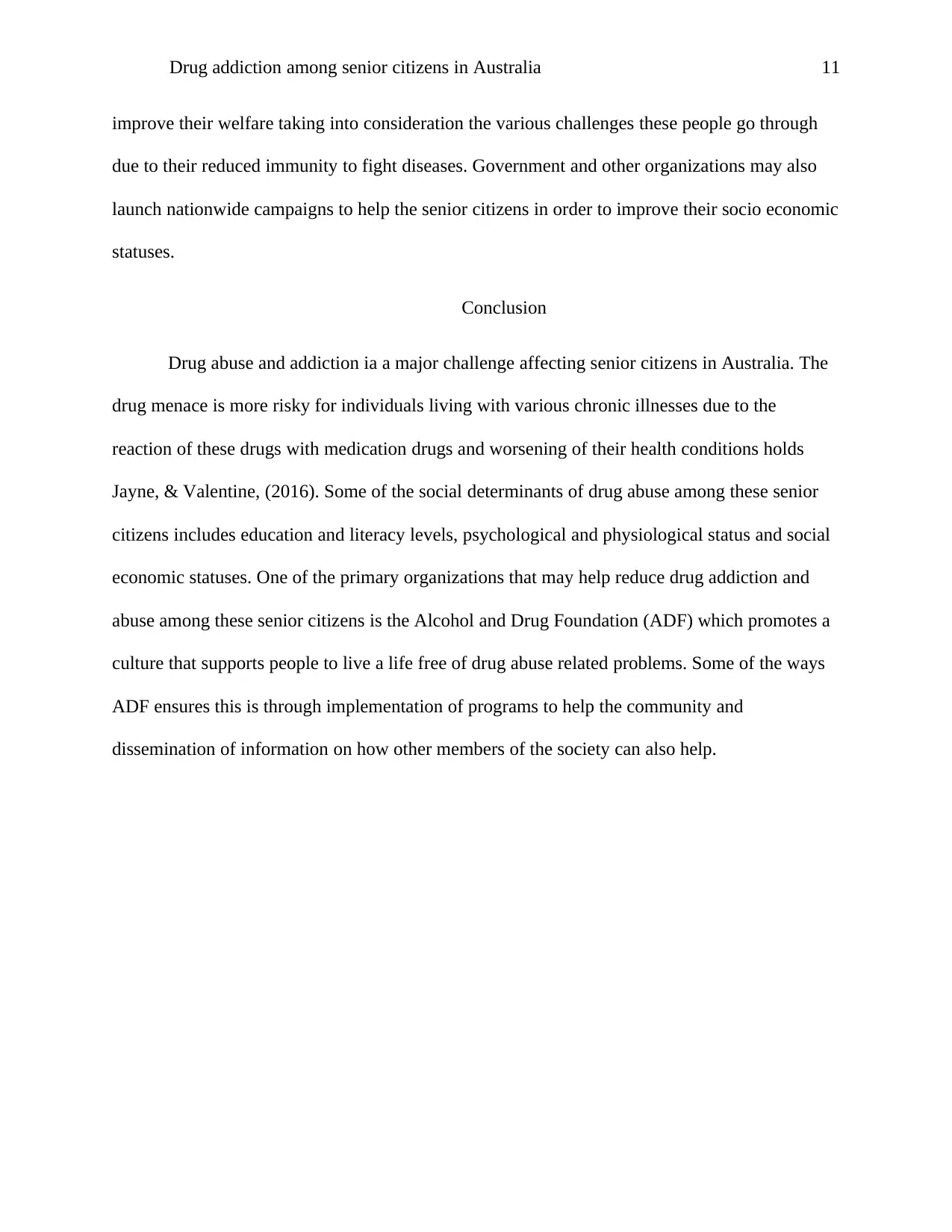
Drug addiction among senior citizens in Australia 11
improve their welfare taking into consideration the various challenges these people go through
due to their reduced immunity to fight diseases. Government and other organizations may also
launch nationwide campaigns to help the senior citizens in order to improve their socio economic
statuses.
Conclusion
Drug abuse and addiction ia a major challenge affecting senior citizens in Australia. The
drug menace is more risky for individuals living with various chronic illnesses due to the
reaction of these drugs with medication drugs and worsening of their health conditions holds
Jayne, & Valentine, (2016). Some of the social determinants of drug abuse among these senior
citizens includes education and literacy levels, psychological and physiological status and social
economic statuses. One of the primary organizations that may help reduce drug addiction and
abuse among these senior citizens is the Alcohol and Drug Foundation (ADF) which promotes a
culture that supports people to live a life free of drug abuse related problems. Some of the ways
ADF ensures this is through implementation of programs to help the community and
dissemination of information on how other members of the society can also help.
improve their welfare taking into consideration the various challenges these people go through
due to their reduced immunity to fight diseases. Government and other organizations may also
launch nationwide campaigns to help the senior citizens in order to improve their socio economic
statuses.
Conclusion
Drug abuse and addiction ia a major challenge affecting senior citizens in Australia. The
drug menace is more risky for individuals living with various chronic illnesses due to the
reaction of these drugs with medication drugs and worsening of their health conditions holds
Jayne, & Valentine, (2016). Some of the social determinants of drug abuse among these senior
citizens includes education and literacy levels, psychological and physiological status and social
economic statuses. One of the primary organizations that may help reduce drug addiction and
abuse among these senior citizens is the Alcohol and Drug Foundation (ADF) which promotes a
culture that supports people to live a life free of drug abuse related problems. Some of the ways
ADF ensures this is through implementation of programs to help the community and
dissemination of information on how other members of the society can also help.
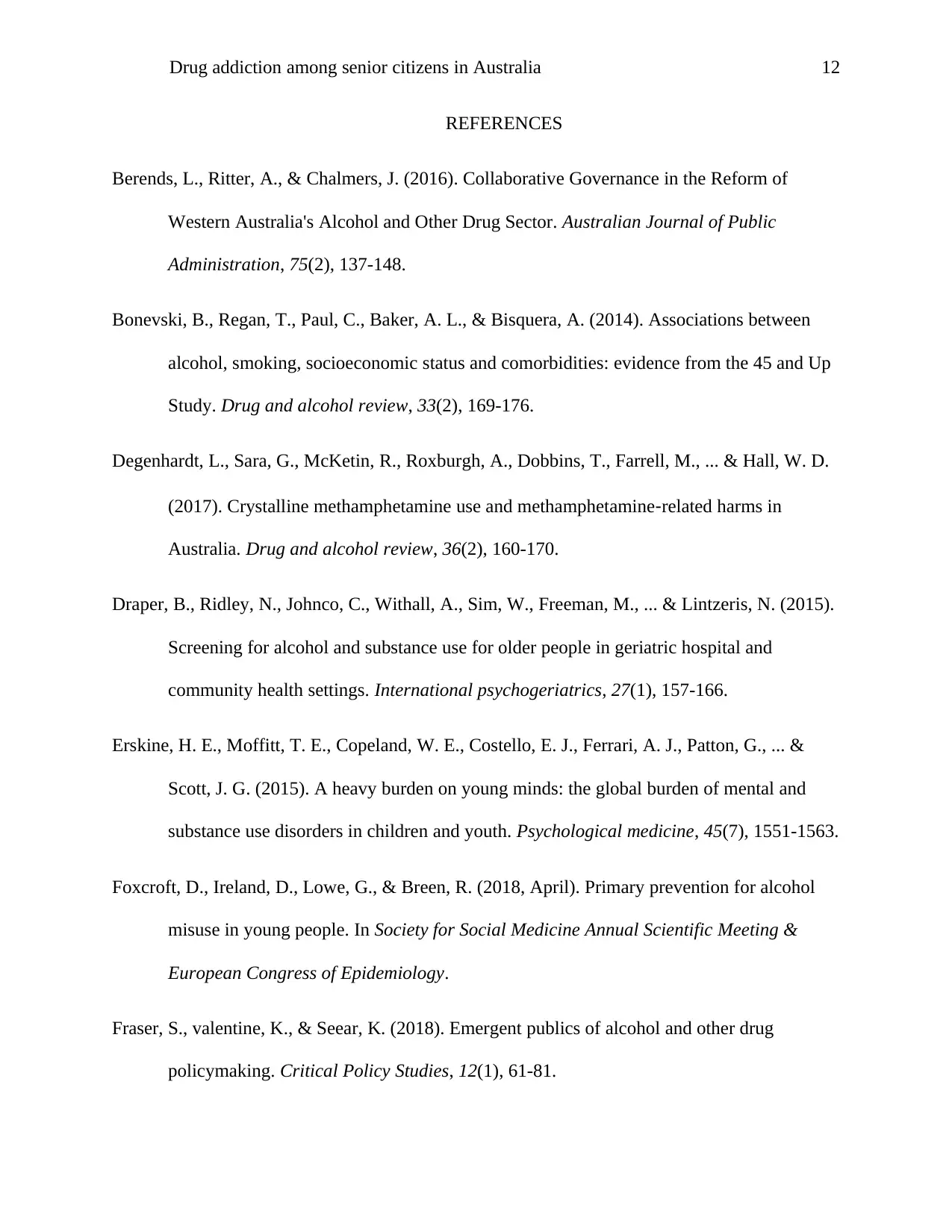
Drug addiction among senior citizens in Australia 12
REFERENCES
Berends, L., Ritter, A., & Chalmers, J. (2016). Collaborative Governance in the Reform of
Western Australia's Alcohol and Other Drug Sector. Australian Journal of Public
Administration, 75(2), 137-148.
Bonevski, B., Regan, T., Paul, C., Baker, A. L., & Bisquera, A. (2014). Associations between
alcohol, smoking, socioeconomic status and comorbidities: evidence from the 45 and Up
Study. Drug and alcohol review, 33(2), 169-176.
Degenhardt, L., Sara, G., McKetin, R., Roxburgh, A., Dobbins, T., Farrell, M., ... & Hall, W. D.
(2017). Crystalline methamphetamine use and methamphetamine‐related harms in
Australia. Drug and alcohol review, 36(2), 160-170.
Draper, B., Ridley, N., Johnco, C., Withall, A., Sim, W., Freeman, M., ... & Lintzeris, N. (2015).
Screening for alcohol and substance use for older people in geriatric hospital and
community health settings. International psychogeriatrics, 27(1), 157-166.
Erskine, H. E., Moffitt, T. E., Copeland, W. E., Costello, E. J., Ferrari, A. J., Patton, G., ... &
Scott, J. G. (2015). A heavy burden on young minds: the global burden of mental and
substance use disorders in children and youth. Psychological medicine, 45(7), 1551-1563.
Foxcroft, D., Ireland, D., Lowe, G., & Breen, R. (2018, April). Primary prevention for alcohol
misuse in young people. In Society for Social Medicine Annual Scientific Meeting &
European Congress of Epidemiology.
Fraser, S., valentine, K., & Seear, K. (2018). Emergent publics of alcohol and other drug
policymaking. Critical Policy Studies, 12(1), 61-81.
REFERENCES
Berends, L., Ritter, A., & Chalmers, J. (2016). Collaborative Governance in the Reform of
Western Australia's Alcohol and Other Drug Sector. Australian Journal of Public
Administration, 75(2), 137-148.
Bonevski, B., Regan, T., Paul, C., Baker, A. L., & Bisquera, A. (2014). Associations between
alcohol, smoking, socioeconomic status and comorbidities: evidence from the 45 and Up
Study. Drug and alcohol review, 33(2), 169-176.
Degenhardt, L., Sara, G., McKetin, R., Roxburgh, A., Dobbins, T., Farrell, M., ... & Hall, W. D.
(2017). Crystalline methamphetamine use and methamphetamine‐related harms in
Australia. Drug and alcohol review, 36(2), 160-170.
Draper, B., Ridley, N., Johnco, C., Withall, A., Sim, W., Freeman, M., ... & Lintzeris, N. (2015).
Screening for alcohol and substance use for older people in geriatric hospital and
community health settings. International psychogeriatrics, 27(1), 157-166.
Erskine, H. E., Moffitt, T. E., Copeland, W. E., Costello, E. J., Ferrari, A. J., Patton, G., ... &
Scott, J. G. (2015). A heavy burden on young minds: the global burden of mental and
substance use disorders in children and youth. Psychological medicine, 45(7), 1551-1563.
Foxcroft, D., Ireland, D., Lowe, G., & Breen, R. (2018, April). Primary prevention for alcohol
misuse in young people. In Society for Social Medicine Annual Scientific Meeting &
European Congress of Epidemiology.
Fraser, S., valentine, K., & Seear, K. (2018). Emergent publics of alcohol and other drug
policymaking. Critical Policy Studies, 12(1), 61-81.
⊘ This is a preview!⊘
Do you want full access?
Subscribe today to unlock all pages.

Trusted by 1+ million students worldwide
1 out of 15
Related Documents
Your All-in-One AI-Powered Toolkit for Academic Success.
+13062052269
info@desklib.com
Available 24*7 on WhatsApp / Email
![[object Object]](/_next/static/media/star-bottom.7253800d.svg)
Unlock your academic potential
Copyright © 2020–2025 A2Z Services. All Rights Reserved. Developed and managed by ZUCOL.





